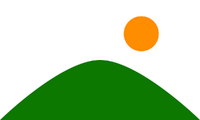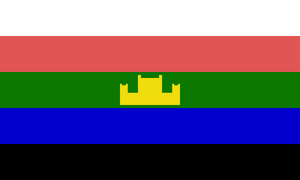Grèsent
Grèsent is a cultural and historical region in central Tiðloten. Once home to a number of independent countries, today it is divided into Upper Grèsent and Lower Grèsent, both constituent countries of the Wiþi Empire. The Suda sea, a large lake slightly south of the centre of Grèsent, is one of the most notable features of Grèsent. Grèsent is known as the "breadbasket of Tiðloten" for its large amount of grain, especially wheat, and for its elemental magic, which is suppressed by the Wiþi Empire authorities.
Upper Grèsent
 | |
| Country of the Wiþi Empire | |
|---|---|
| Local name | Xich Grèsent |
| Capital | Agrasichas |
| Largest city | Trèsicha |
| Official languages | Senta Grèstilsa, Adcovtle |
| Demonym | Upper Grèstilsan |
| Government | Constitutional monarchy |
| Currency | Zelum (locally Zèlu) |
Upper Grèsent is a country of the Wiþi Empire in Grèsent, roughly comprising the lands of Grèsent north of the Suda Sea. It contains the historic capital of Ongrèsent, Ongrèstilsa, and the largest amount of wheat production in Tiðloten. Its current administrative capital is Agrasichas, while its current largest city is Trèsicha.
Geography
Largely agricultural near Agrasichas and Trèsicha, pockets of forest become more frequent further north and west. The Norecha mountains (known as the Wiþi mountains in Covtle) run east-west at the northern end. The Suda sea, a large inland sea, forms the boundary with Lower Grèsent.
Climate
Mostly humid continental climate (Dfa).
Languages
Senta Grèstilsa is spoken in most of Upper Grèsent. A variety called Naxo is spoken in the far north near Atlée.
History (1876 to present)
This section needs expansion.
Lower Grèsent
 | |
| Country of the Wiþi Empire | |
|---|---|
| Local name | Gē Gēo |
| Capital | Dokagrolis |
| Largest city | Dokagrolis |
| Official languages | Mēeu Gēo, Adcovtle |
| Demonym | Lower Grèstilsan |
| Government | Constitutional monarchy |
| Currency | Zelum (locally Zēu) |
Lower Grèsent is a country of the Wiþi Empire in Grèsent, roughly comprising the lands of Grèsent south of the Suda sea. It contains the historical territories of Dokagrolis and Sudasichas. Somewhat agricultural, especially along the coast, it becomes forested quickly inland. The Āea mountains (known in Covtle as the Cientla mountains) form the southern border.
Geography
The population of Lower Grèsent is very coastal, living near the coast of the Suda sea and stretching inland slightly more around the Atlent river towards Dokagrolis. In the east, the ridgeline of the Āea mountains form the southern border, while to the west the border follows roughly west from the ridgeline to the Voigai mountains.
Climate
Mostly hot-summer humid continental climate (Dfb).
Languages
Mēeu Gēo is spoken throughout Lower Grèsent. Traditionally regarded as a corrupted variety of Senta Grèstilsa, it today is recognised as its own language.
History (1876 to present)
This section needs expansion.
History (Antiquity to 1876)
Early history
Little is known about the earliest inhabitants of the region, who are suspected to have been related to the original inhabitants of Covtle. The groups in this region stayed nomadic for longer than in many other regions, thereby leaving little evidence of their settlement.
A transition to agriculture began in roughly -500 and continued to roughly 0. Construction in this time was often wood-based, so few examples survive. However, a sharp transition to stoneworking occurred with the invasion of the area from Fole Enkan surrounding the Suda sea in 447. Remains, in particular of barracks and roads from this era, show a clear Pìleloget-Enkan style.
Bolhik and current population arrival
Around the year 650, a sudden swell in population in the northernmost region of Grèsent, Naxov Grèsent, led to a rapid expansion throughout the area. In 705, they united under the king Bolhik and swept through the entire region, defeating the Fole Enkan in 706 and gaining control of the region. Bolhik's followers brought with them several cultural practices, including the element-based worship and magic that was forbidden in the former empire. However, Bolhik left no children, and so control of the region quickly devolved to several local warriors who controlled the countryside.
Consolidation
Power began to concentrate once again in the 1200s and 1300s, beginning in Méreh Grèsent south of the Suda sea. The Kingdom of Dokagrolis was established in 1242 by King Xonfe, followed by the Kingdom of Sudasichas in 1277 with King Telge. To the north in Senta Grèsent, the Kingdom of Trèsicha was consolidated in 1308 by King Mantrèa. Its historical rival, the Kingdom of Agrasichas, was formed one year later in 1309 by King Onxonde. These rivals around the Suda sea fought several wars throughout the 1300s and early 1400s.
Konfode and the establishment of Ongrèsent
In 1456, a local warlord from Ontebonsad named Konfode formed a ruthless army and began conquering the surrounding small kingdoms, creating a new kingdom that he named Ongrèsent ("The One Grèsent"). After conquering Trèisicha in 1471 and Agrasichas in 1473, Konfode founded the city of Ongrèstilsa to be his capital. The only small kingdom north of the Suda Sea remaining after this conquest was Lèrtsbon.
While Konfode attempted to create a centralised administrative state, this did not last long under his son Oknove, who, when faced with an unruly population, delegated much of his authority to the Dukes of Ongrèsent, making them responsible for maintaining order within their duchies. For the next several centuries, the Dukes of Ongrèsent held a far more important role than the kings, even though the king was their superior.
South of the Suda sea, the Kingdoms of Sudasichas and Dokagrolis continued to fight wars, with the control of the Mēeuiflo region particularly contentious. Between 1400 and 1700, there were no less than 17 conflicts between Sudasichas and Dokagrolis.
First Plimotem teñe and Rightful heirs
In 1731, the neighbouring Covtle launched an attack on Ongrèsent aimed at taking the port city of Agrasichas, rationalised as a necessity to expand trade. In a rapid victory widely attributed to their superior military strategy, they managed to take and hold the city within the year. The King of Ongrèsent, King Echme, signed the first Treaty of Dokagrolis with Covtle, where Ongrèsent forwent all rights to Agrasichas. Duke Grèdíe of Suda said he would not honour the treaty, causing the spectre of further war. However, King Echme, with the support of most of the other Dukes, changed the rules of succession to sideline Grèdíe. This created a long-lasting movement called the "Rightful Heirs" which launched underground plots to restore the old system, which they viewed as the only legitimate system. Covtle organised their territory of Agrasichas as their first Plimotem teñe ("External territory") with an appointed Tiþenat ("Governor-general").
Further Adcovtle expansion into Grèsent
In 1772 Covtle launched another attack on Ongrèsent, once again described as a necessity to expand trade, this time aimed at taking the other port city of Trèsicha. This attack was once again successful, resulting in the second Treaty of Dokagrolis, where Ongrèsent forgoed all rights to Trèsicha. Covtle added Trèsicha to the Plimotem teñe.
In 1814 Covtle attacked for a third time, hoping to form a trade corridor with Lèrtsbon, this time aiming for the city of Lèrtsfort. Once again they took control of it, and all of the territory east of the Agra river, in under a year. The third Treaty of Dokagrolis was signed, giving the entirety of the Duchy of Suda to Covtle. Covtle added the Duchy of Suda to the Plimotem teñe.
The Šaxme and the Pabaxeranxe

After its third defeat to Covtle, the remaining Dukes of Ongrèsent created a council called the Šaxme. Unlike the previous system of keeping each duke responsible for their own duchy, they agreed to appoint a single Gamaranxe ("Leader of the Armies") to oversee the collective defence of Ongrèsent. The Gamaranxe arranged the existing soldiers in more efficient units, but more importantly created a new force called the Pabaxeranxe ("Magic Warriors") who honed their elemental magic skills in their elements to use in war.
Adcovtle protectorates and the Nine Years' War
In 1834 Covtle signed a treaty with Lèrtsbon declaring it a protectorate. Similar treaties were signed with Sudasichas in 1843 and Dokagrolis in 1854. Throughout this time, relations between Ongrèsent and Covtle became increasingly tense, with both accusing the other side of provocation several times. Several border skirmishes occurred, all ending in stalemates.
Finally, in 1867, King Želhus of Ongrèsent ordered the armies of Ongrèsent to invade Lèrtsbon. Queen Eðamu of Covtle, after consulting with lapazadapalavi (parliament), declared war on Ongrèsent.
The resulting 9-year war was extremely costly for Covtle, but was devastating to Ongrèsent. Despite holding Covtle off for a significant period of time with the Pabaxeranxe, Covtle ultimately took control of the entirety of Ongrèsent. The entire territory was added to the Plimotem teñe.